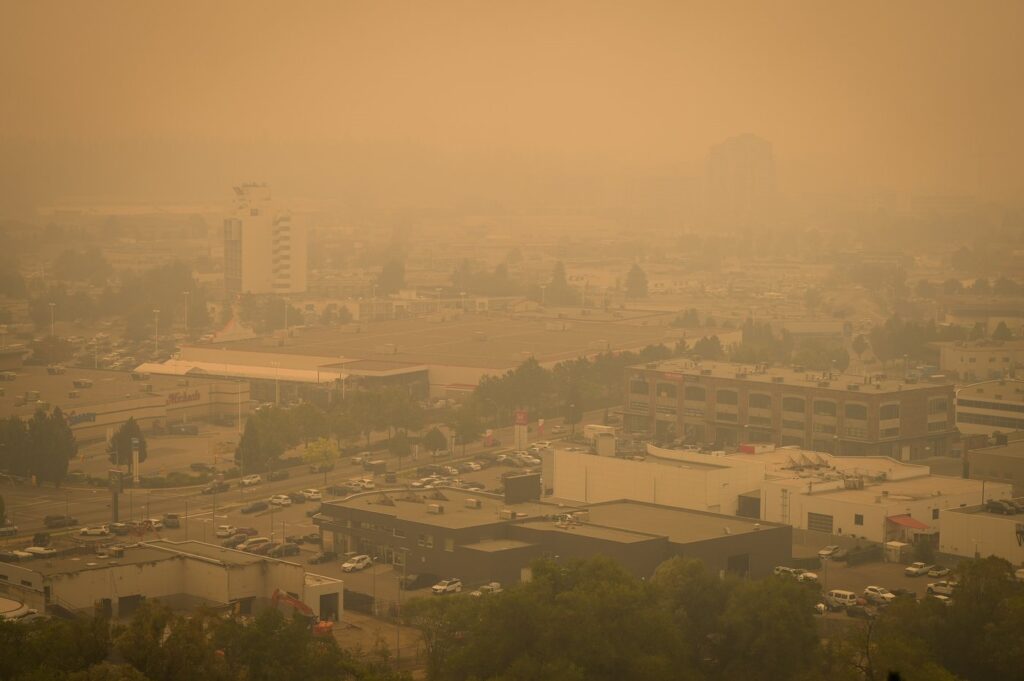What P&C industry can expect from Kelowna wildfires

In an eerie coincidence, almost 20 years to the day wildfires caused $200 million in insured damage back in 2003, Kelowna is burning once again.
About 30,000 people in the southern Interior region of B.C. — about a third of them from the Kelowna area – are currently under evacuation orders, CBC reported Monday.
Insurance Bureau of Canada has confirmed claims from damage due to wildfires in West Kelowna (pop. 36,000) and other areas of B.C.’s southern interior have started to come in.
“Several communities in both British Columbia and Northwest Territories are reporting damage to personal residences and commercial structures due to the wildfires,” IBC reported Sunday. “At this time, it is too early to provide any estimates of insured damages, as wildfires are still raging in various regions.”
Officially, so far, West Kelowna’s fire chief says at least 50 local structures have been lost to the 110-square-kilometre McDougall Creek fire burning on both sides of British Columbia’s Lake Okanagan, per Canadian Press. Unofficially, one P&C industry source told CU, the loss so far is “hundreds of structures.” Official totals should roll in soon since authorities are creating a task force to count loss structures.
Catastrophe Indices and Quantification Inc. (CatIQ) said claims from the ongoing Kelowna fires are anticipated for temporary accommodations (additional living expenses), property losses, and smoke damage claims.
Additionally, “BC Hydro has indicated power outages for over 600 customers in West Kelowna since Friday so there could be white goods damage [i.e., refrigerators, freezers] and food spoilage claims as well, even if the home is untouched from the flames,” CatIQ president and CEO Laura Twidle told Canadian Underwriter Monday.
Glenn McGillivary, managing director of the Institute for Catastrophic Loss Reduction (ICLR), said fires in the Kelowna area are playing out as urban-wildland interface fires typically do.
“The combination of dry fuel and high wind led to rapid spread of fire as embers were blown forward of the fire front, igniting things like dry grass, wood piles, wood fences, sheds, decks etc., which lead to the ignition of structures,” McGillivary said Monday.
“Structure-to-structure spread begins to occur and you get an urban conflagration. With the intense winds in the Okanagan the evening of Aug. 17, embers were blown over Lake Okanagan, igniting properties in the City of Kelowna.
B.C. has seen a record number of wildfires in 2023, making it all the more likely the P&C industry would see some kind of wildfire Cat event.
“This year, Canada has not just broken the all-time record for area burned, it has obliterated it,” McGillivray says. “Currently, more than 14.1-million hectares have been charred, more than double the previous record set in 1989 when 7.6 million hectares burned, and it’s only August.
“More than 5,800 fires have been recorded this year, and while things have settled down in the east, B.C. is having its worst year ever. With so much fire on the landscape, the chances of an event like this were dramatically increased.”
Industry research in 2015 expressed concern that the Kelowna area could see a repeat of the 2003 wildfire events. The ICLR study looked at a specific neighbourhood that burned in the 2003 Kelowna wildfires to see how the community responded to take precautions against it happening again. It is not known if the same area in the ICLR report has experienced damage, but the general conclusions of the report emphasized the importance of:
Adopting FireSmart practices (i.e., emergency planning, laws and bylaws around development planning, and interagency cooperation with neighbourhoods
Communications and public awareness around FireSmart principles
Vegetation, landscaping and reducing the source of fire fuel around homeowners’ properties.
PHOTO Caption and Credit: British Columbia’s desperate battle against hundreds of wildfires continues on multiple fronts today, but no new evacuation orders have been added overnight to the thousands already in place across the province. Smoke from wildfires fills the air in Kelowna, B.C., Saturday, Aug. 19, 2023. THE CANADIAN PRESS/Darryl Dyck



